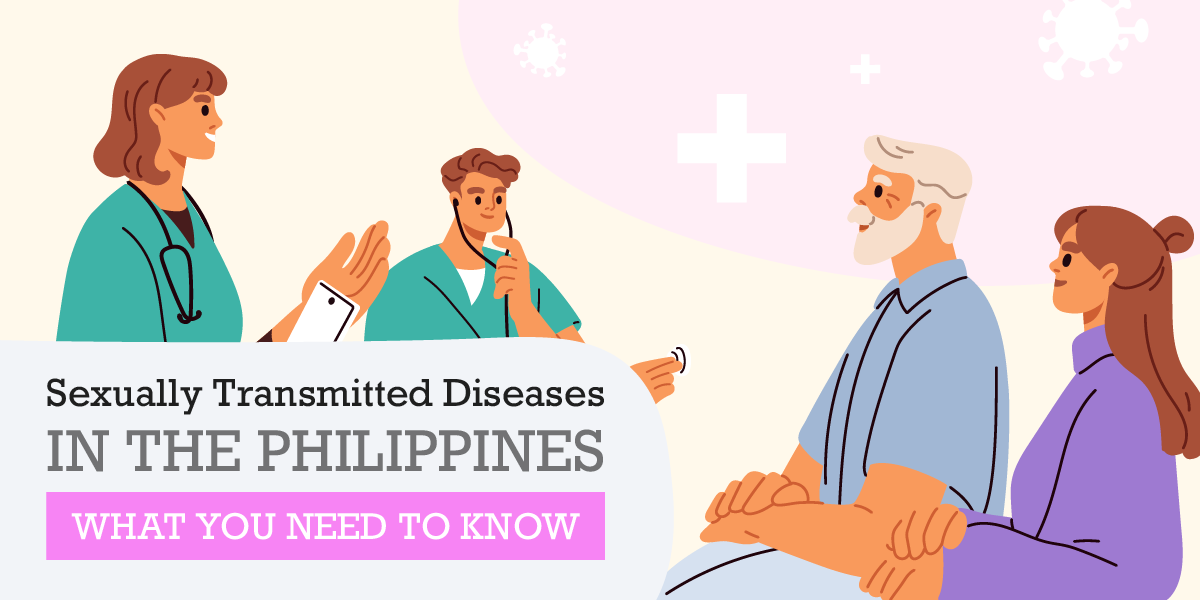Sexually transmitted diseases (STDs) are becoming a growing concern in the Philippines, especially among young adults and people of reproductive age. The Department of Health has reported a steady increase in cases of sexually transmitted infections, such as chlamydia, gonorrhea, and syphilis, in recent years. Yet, many Filipinos remain unaware of how to recognize the symptoms or where to get help.
However, the problem extends beyond the infection itself. The stigma surrounding STDs often prevents individuals from seeking medical help, creating a barrier to education and limiting access to affordable healthcare. These challenges make it harder to address the issue effectively.
This guide is designed to help you understand the most common sexually transmitted infections in the Philippines, how they spread, their symptoms, and where you can get tested and treated.

Understanding STDs: Why Awareness Matters
STDs are a growing concern in the Philippines, especially among young adults. Around 189,000 are currently living with HIV, with projections estimating a rise to 401,700 by 2030. Other sexually transmitted infections in the Philippines—like chlamydia, gonorrhea, and syphilis—often go undetected due to mild or no early symptoms.
Additionally, stigma and misinformation prevent many from seeking testing or treatment. Surveys show:
- 43% of teens (15-17) are afraid of their test results,
- 36% of young adults (18-24) say they don’t have time to get tested, and
- 64% of adults (25+) don’t see the need at all.
But here’s the truth: knowing how STDs spread, what to watch out for, and where to get tested makes a significant difference. Awareness saves lives—and helps protect both you and your partners.
What Are the Most Common STDs?
STDs are more common than many realize. Here’s a quick overview of the ones you should know:
1. HIV (Human Immunodeficiency Virus)
HIV weakens the immune system and, if untreated, can lead to AIDS. It’s mainly spread through unprotected sex, needle sharing, or from mother to child during childbirth or breastfeeding.
2. Gonorrhea
Gonorrhea is a bacterial infection passed through vaginal, anal, or oral sex. It’s often symptomless but may cause painful urination and unusual discharge. If untreated, gonorrhea can lead to serious health issues like pelvic inflammatory disease (PID) or infertility, especially in women.
3. Syphilis
Syphilis starts with small, painless sores, usually around the genital area, and can cause rashes, sores in the mouth or genitals, and flu-like symptoms. If left untreated, it can damage the heart, brain, and other organs.
4. Chlamydia
Chlamydia is usually symptomless but can cause infertility and pregnancy complications if untreated. It affects both men and women, but women often suffer more severe consequences.
5. Genital Herpes
Caused by the herpes simplex virus (HSV-1 or HSV-2), genital herpes leads to painful blisters in the genital area, often accompanied by itching and discomfort. Once contracted, the virus remains in the body for life, with periodic outbreaks triggered by stress, illness, or other factors. While there is no cure, outbreaks can be managed with antiviral medications.
6. HPV (Human Papillomavirus)
HPV is a group of viruses that can cause genital warts and certain cancers. It’s mostly spread through skin-to-skin contact during sexual activity. Some strains of HPV can cause warts in the genital area, while others can affect the cervix, leading to cancer later in life.
Recognizing the Signs of STD
Symptoms vary by infection—but many STDs share similar signs. If you notice any of the following, see a healthcare provider right away:
Painful urination and unusual discharge
Pay attention to any burning sensation while urinating or any unusual discharge from your genitals. This discharge may vary in color (e.g., yellow, green) and consistency.
Sores, blisters, or warts
Sores, blisters, or warts appearing around your genital area or mouth should not be ignored. These lesions can be painful and may sometimes rupture. Genital warts might present as small, flesh-colored growths.
Itching, irritation, or redness
Itching, irritation, or redness in the genital region can be a sign of an underlying issue. This discomfort may occur with or without visible sores.
Flu-like symptoms
Flu-like symptoms like persistent fatigue, fever, or swollen lymph nodes can sometimes indicate an STD, particularly in the initial weeks following exposure.
Abnormal bleeding between periods
For individuals with a uterus, spotting between menstrual periods or bleeding after sexual intercourse warrants prompt medical attention, as it could be a sign of an infection.
Note: Remember, these symptoms can also be associated with other conditions. Do not to self-diagnose. If you notice any of these signs, speak with a healthcare professional for an accurate diagnosis and appropriate management. Early detection and treatment help avoid complications and further transmission.
Safe Practices to Reduce the Risk
You deserve to feel good about your body and your choices. These tips can help reduce your risk:
1. Use protection
Condoms and dental dams are your first line of defense. They prevent direct contact with potentially infected fluids, significantly lowering the chances of transmission.
While they aren’t 100% foolproof, using protection consistently and appropriately can significantly reduce your risk of contracting common STDs like HIV, gonorrhea, and chlamydia.
2. Get vaccinated
One important defense against several STIs is vaccination:
- HPV Vaccine: Gardasil 9 protects against HPV types 6, 11, 16, and 18. A 2023 study showed that children vaccinated before age 14 had five times less risk of genital warts or HPV-related cancers.
- Hepatitis B Vaccine: Widely available and effective. With over 95% immunity, the Hepatitis B vaccine offers long-lasting protection (20+ years, possibly lifelong) and prevents mother-to-child transmission.
3. Get tested
You don’t need symptoms to get tested. Annual or biannual testing is a healthy habit—especially if you’re sexually active. It ensures you’re taking care of yourself and your future.
4. Limit sexual partners
Fewer partners = lower risk. It’s natural to want to feel connected with others, but the fewer sexual partners you have, the lower the risk of exposure to STDs.
If you’re in a non-monogamous setup, be open and honest with each other about your sexual health. This is one of the best ways to keep everyone safe. Remember that it’s okay to set boundaries and ask for the protection you deserve.
5. Avoid risky behaviors
We all have moments when we make decisions that aren’t ideal, but the choices you make now can protect your health later. Unprotected sex, drug use, or engaging in sex under the influence can raise your risk. Always pause and consider the long-term effects of your choices.
Finding STD Clinics and Testing Centers
If you’re concerned about your sexual health, getting tested is an important step. Fortunately, there are several places in the Philippines where you can get tested for STDs, whether you’re looking for affordable options, privacy, or additional support. Here’s where you can go:
Government health centers
Run by the Department of Health (DOH), these centers offer free or low-cost STD and HIV testing. It’s a good option for those who may not have a lot of money to get checked in private institutions. Services are confidential and community-based.
NGOs and non-profits
Groups like LoveYourself and offer free HIV testing, counseling, and sexual health education nationwide, making them a great option if you want support and to learn more information.
Private hospitals and clinics
For those seeking faster, more private service, many clinics offer comprehensive STD testing for a fee. They have trained staff and provide confidential testing. Many people choose private clinics because they are more flexible with appointments and give quick, discreet services.
How Are STDs Treated?
Treating sexually transmitted diseases in the Philippines can feel overwhelming, but you’re not alone—and help is available. Treatment depends on the infection—but the earlier you act, the better.
1. Antibiotics
If you’ve been diagnosed with a bacterial STD like gonorrhea, syphilis, or chlamydia, your doctor will likely prescribe antibiotics. Make sure to finish every last dose—even if you start feeling okay. Stopping too soon can give the bacteria a chance to fight back and become resistant, meaning the meds might not work next time.
2. Antiviral medications
For viral infections like HIV, herpes, or HPV, antiviral meds won’t cure the virus, but they can ease symptoms, reduce outbreaks, and help prevent transmission. For people living with HIV, treatments like ART can support the immune system and keep you feeling strong.
3. Vaccination
Vaccines are a powerful way to prevent future infections. The HPV vaccine, for example, is most effective before exposure, so early vaccination is highly recommended. It helps prevent the types of HPV that cause genital warts and certain cancers. If you’re a parent, getting your child vaccinated early is one of the best ways to protect them.
4. Regular follow-ups
Stay in touch with your healthcare provider after diagnosis. Follow-up visits and routine testing help ensure your body’s healing well—and give you peace of mind. You deserve care that supports your health every step of the way.
Protect, Prevent, and Prioritize Your Health
Dealing with an STD diagnosis can feel overwhelming and scary, but it’s important to remember that you’re not alone—and it’s not the end of the road. With the right information, testing, and treatment, you can take control of your sexual health.
At Pink Bunny, we’re more than an adult shop—we’re your partner in pleasure and protection. We offer resources and guidance through our Bunny Blog, tools to help you feel safe and confident, and support for your sexual well-being every step of the way.
Got questions? Your health matters—always.




